Prerequisites
Before continuing, ensure you have the following:-
A valid TechWolf contract and access to a live TechWolf tenant.
- This tenant must contain Jobs corresponding to the Job Roles present in
SAP SuccessFactors. This can be achieved by either:
- Using the Standard Job Data Input Integration .
- Writing custom input integrations. When doing this, ensure the
TechWolf SkillEngine API Jobs are linked with their SAP
SuccessFactors Job Role counterparts by using the SAP Job Role ID
(
Role_GUID) as the TechWolf Job ID (external_id).
- This tenant must contain Jobs corresponding to the Job Roles present in
SAP SuccessFactors. This can be achieved by either:
-
An SAP SuccessFactors environment with Talent Intelligence Hub and Job
Profile Builder implemented.
Enabling Talent Intelligence Hub activates the Attributes Library, allowing the use TechWolf skills in your SuccessFactors environment.Enabling Job Profile Builder allows using Job Families and Job Roles. TechWolf synchronizes skill profiles between SAP SuccessFactors Job Roles and SkillEngine API Jobs.
- Access to the TechWolf SFTP server to host the integration files.
- An SAP support case to whitelist the TechWolf SFTP server .
-
The necessary setup of the Attributes Library in SAP SuccessFactors.
- This includes at least the following:
- A proficiency rating scale of your choice, aligned with the one configured for SAP in TechWolf. Preferably, the default TechWolf proficiency scale (1-5) is used. Contact your TechWolf representative for the current configuration, or to update the configuration. See How To: Manage the Skill Proficiency Rating Scale for more information on how to manage the proficiency rating scale in SAP SuccessFactors.
- The desired set of TechWolf skills present and active in your SAP Attributes Library, as Attributes of the default “Skill” iconType
- More information on the Attributes Library and the maintenance of the Attributes Library in SAP SuccessFactors can be found in the Skills Taxonomy Sync installation guide.
- This includes at least the following:
SAP SuccessFactors Configuration
TechWolf has already pre-configured some parts of the integration. The following ZIP archive contains the necessary files that will be used in the subsequent steps to configure the integration in SAP SuccessFactors.Required files
Required files for the SAP Job Skill Sync Integration
-
Find out the correct SAP SuccessFactors Company ID
- As an SAP administrator, log into the SAP SuccessFactors environment you want to configure the integration for.
- Click on your profile icon in the top right corner and select “Show
version information”.

- The Company ID will be shown in the resulting window.
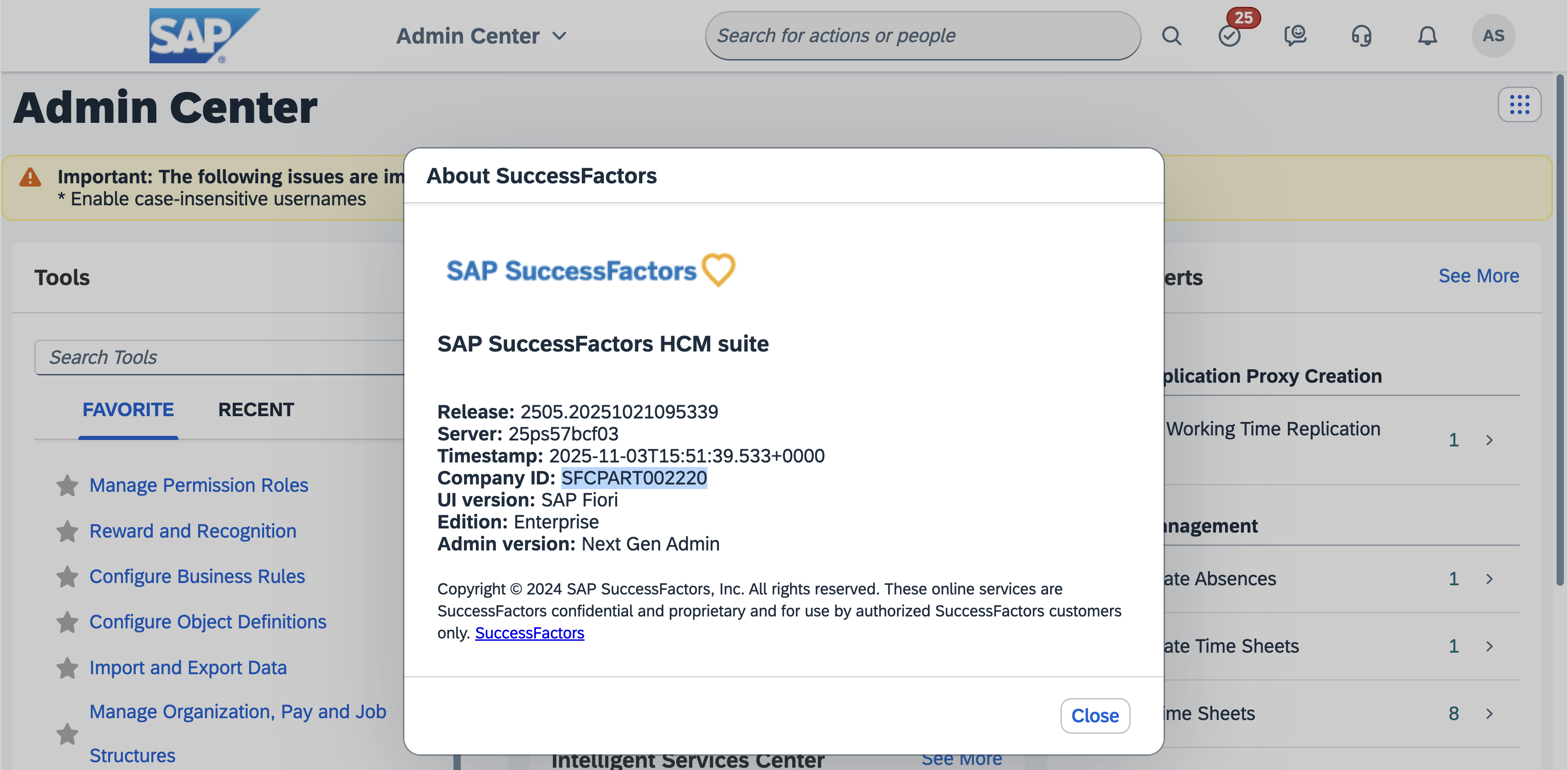
-
Find out the correct SAP SuccessFactors API URL
- As an SAP administrator, go to SAP for Me (if you have multiple credentials, sign in with your S-User credentials).
- In the Public Cloud Systems table, find the system you want to configure
the integration for.
- This system should have the value “SAP SuccessFactors HCM” in the
Cloud Servicecolumn.
- This system should have the value “SAP SuccessFactors HCM” in the
- The
Data Centercolumn will show the location of the data center of the system, e.g. “Netherlands: Eemshaven”.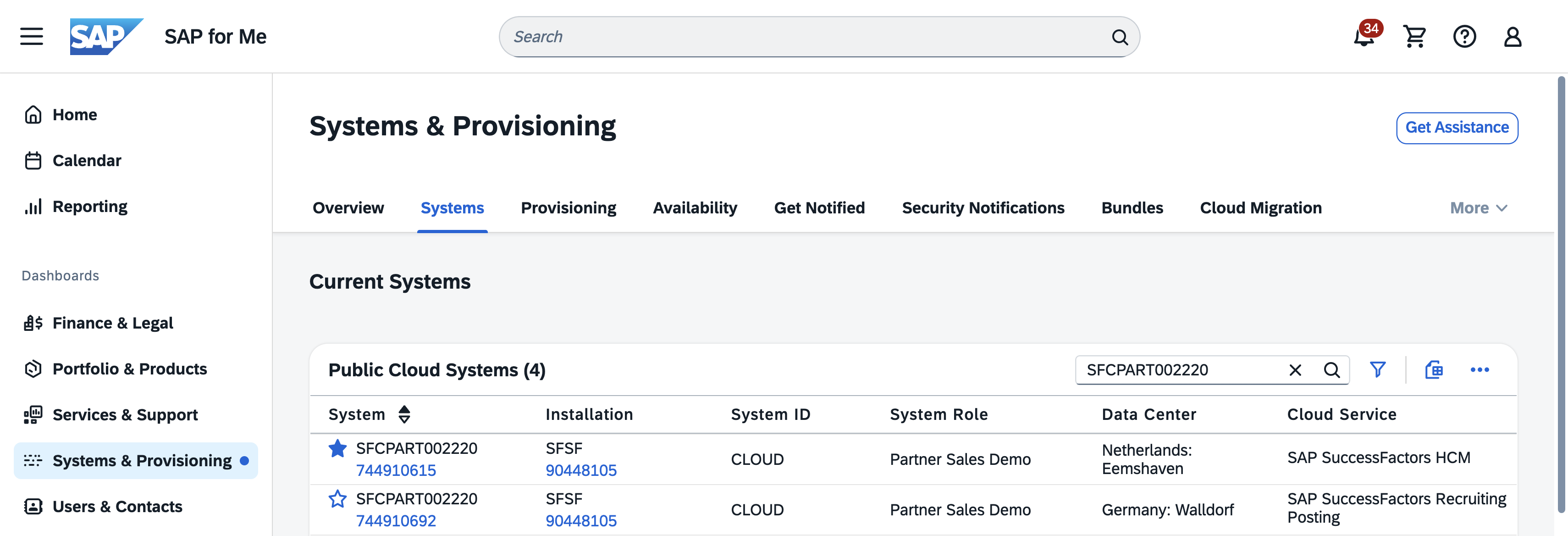
- Go to the List of SAP SuccessFactors API Servers
- In the API Servers table, find your Data Center.
- This Data Center should have the previously determined data center
location as the value of the
Locationcolumn. Note that the location name might differ in format from the location name in the previous step, e.g. “Eemshaven, The Netherlands” vs “Netherlands: Eemshaven”. Among all rows with this location, find the row with the appropriate value for theEnvironmentcolumn.
- This Data Center should have the previously determined data center
location as the value of the
- The
API Servercolumn will show the API URL for the API Server.
-
Create a TechWolf User in your SAP SuccessFactors environment
- In the search bar at the top right of SAP SuccessFactors, enter
Import Employee Data. - In the resulting window, under the
Select an entitydropdown, choose “Basic Import”. In theChoose Filefield, upload thetechwolf_api_user_definition.csvfile provided by TechWolf.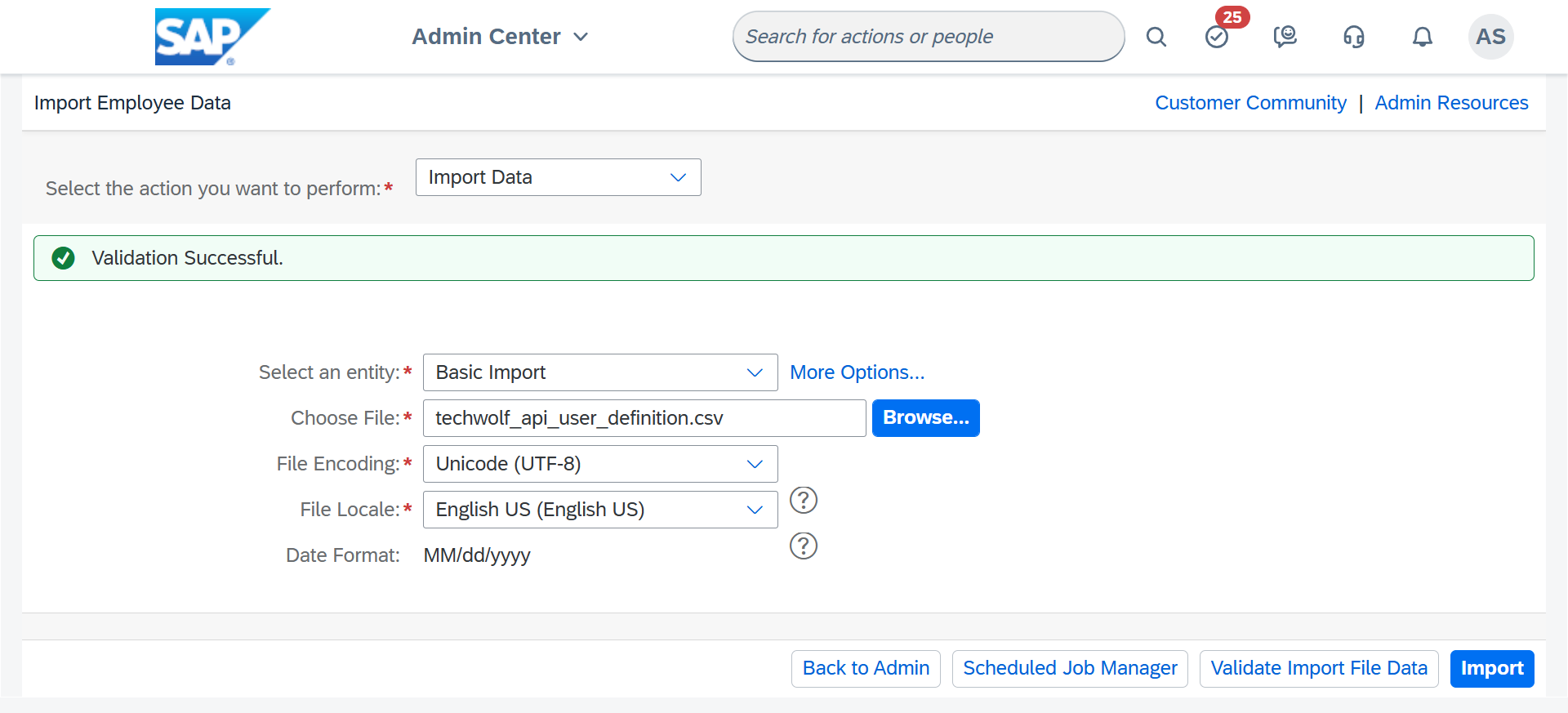
- Leave the other fields unchanged and click
Validate Import File Data. If the validation is successful, clickImport.
If you already created a TechWolf User for the another TechWolf - SAP SuccessFactors Integration, this step can be skipped. - In the search bar at the top right of SAP SuccessFactors, enter
-
Create a new OAuth2 Client Application
- In the search bar at the top right of the screen, enter
Manage OAuth2 Client Applicationsand press enter. - In the window that opens, click
Register Client Application.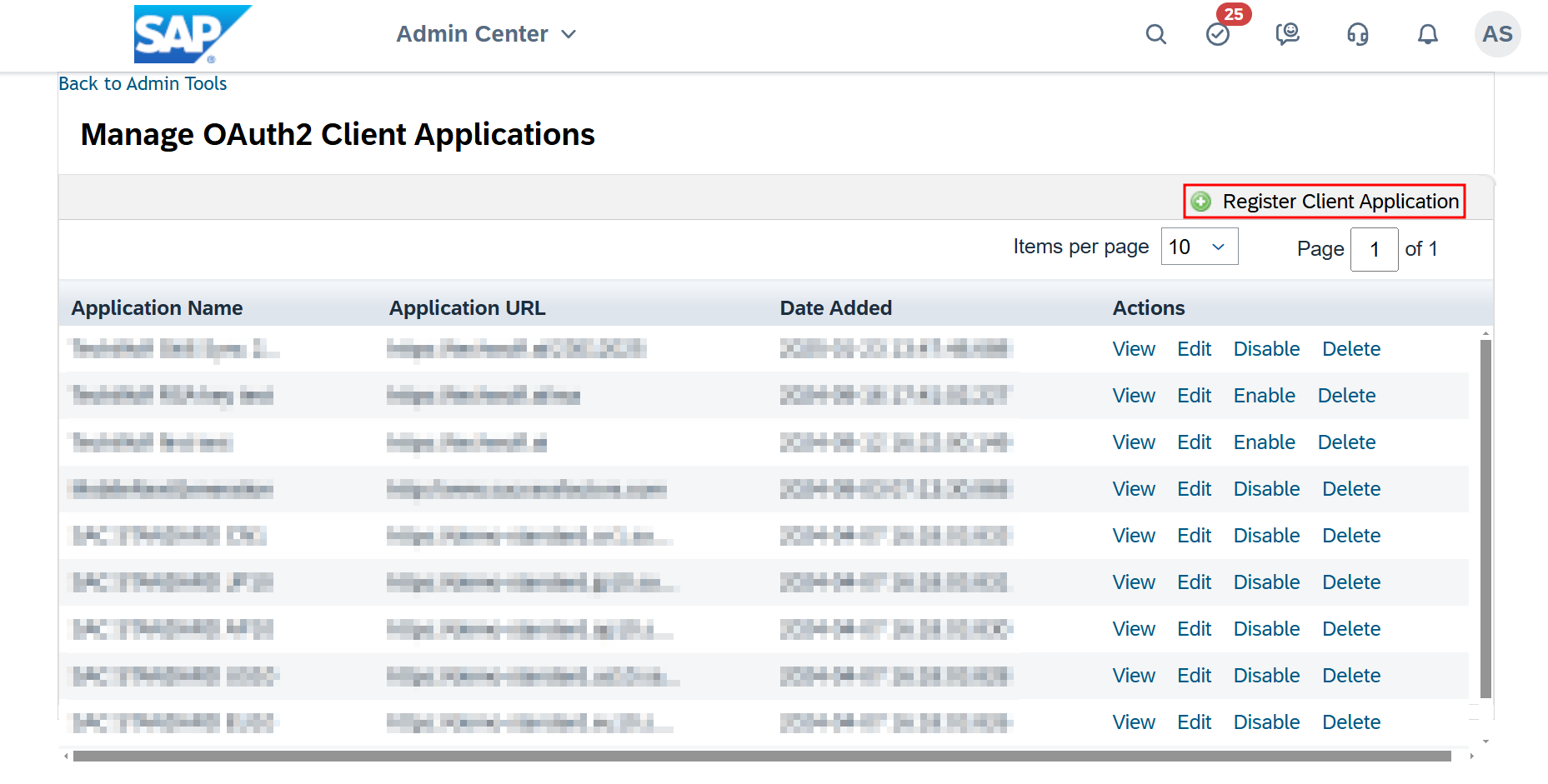
- In the resulting page, the following fields must be filled in:
Application Name: “TechWolf Skill Sync”Application URL: “https://techwolf.ai”Bind to Users: Check the checkboxUser IDs:TechWolf_TIH_GP(refers to the user created in the previous step)X.509 Certificate: Go to your TechWolf point of contact to request the certificate file. Once you received the file, open it. It will have the following text guards around it: “-----BEGIN CERTIFICATE-----” and “-----END CERTIFICATE-----”. Copy all the text in between these guards and paste it into theX.509 Certificatefield.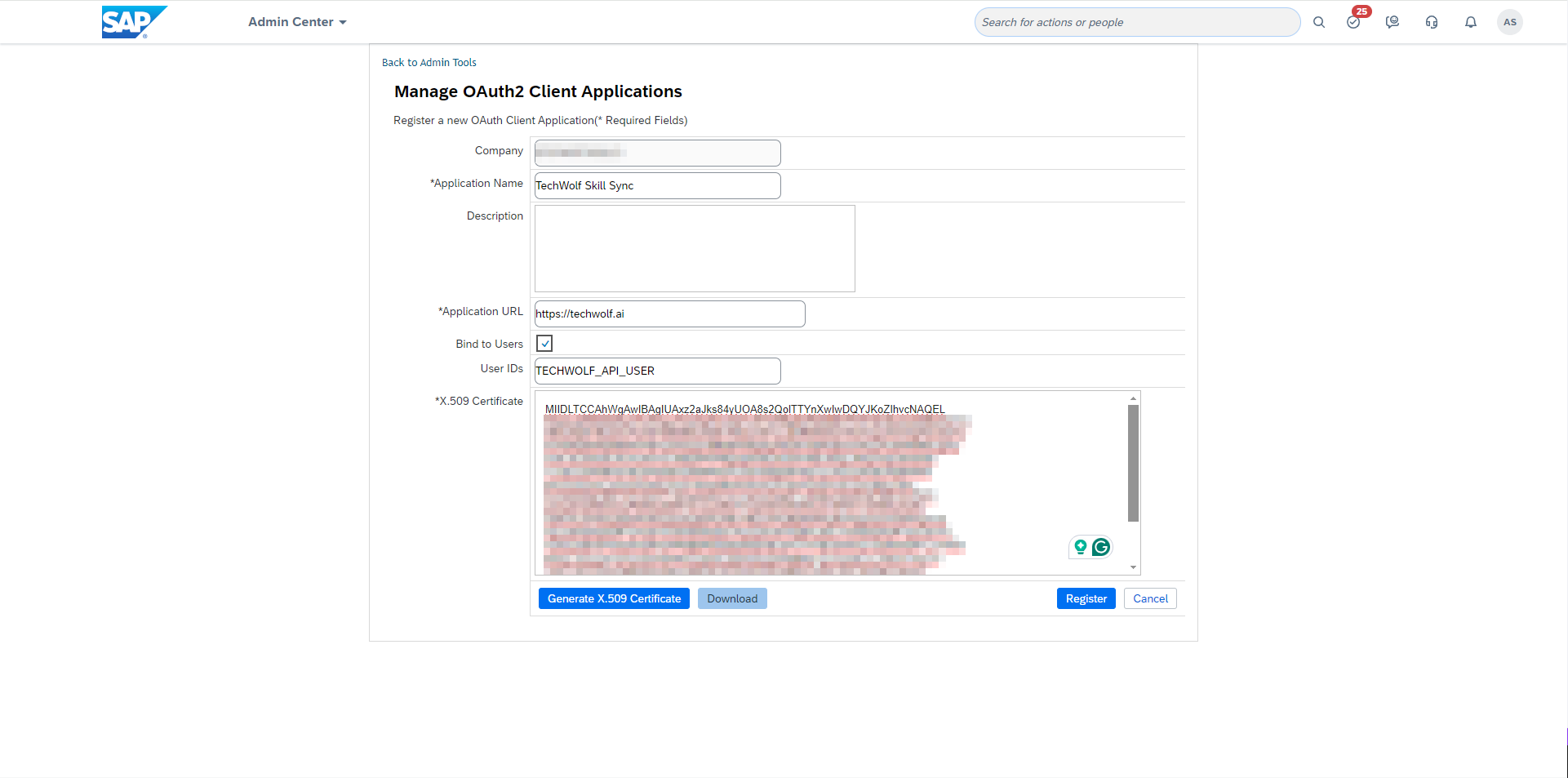
- Now, click
Register. - Once the Client Application is registered, go back to the
Manage OAuth2 Client Applicationspage and find the application you just created. ClickViewon it. - On this view, you can see the
API Keyyou will need for the integration configuration.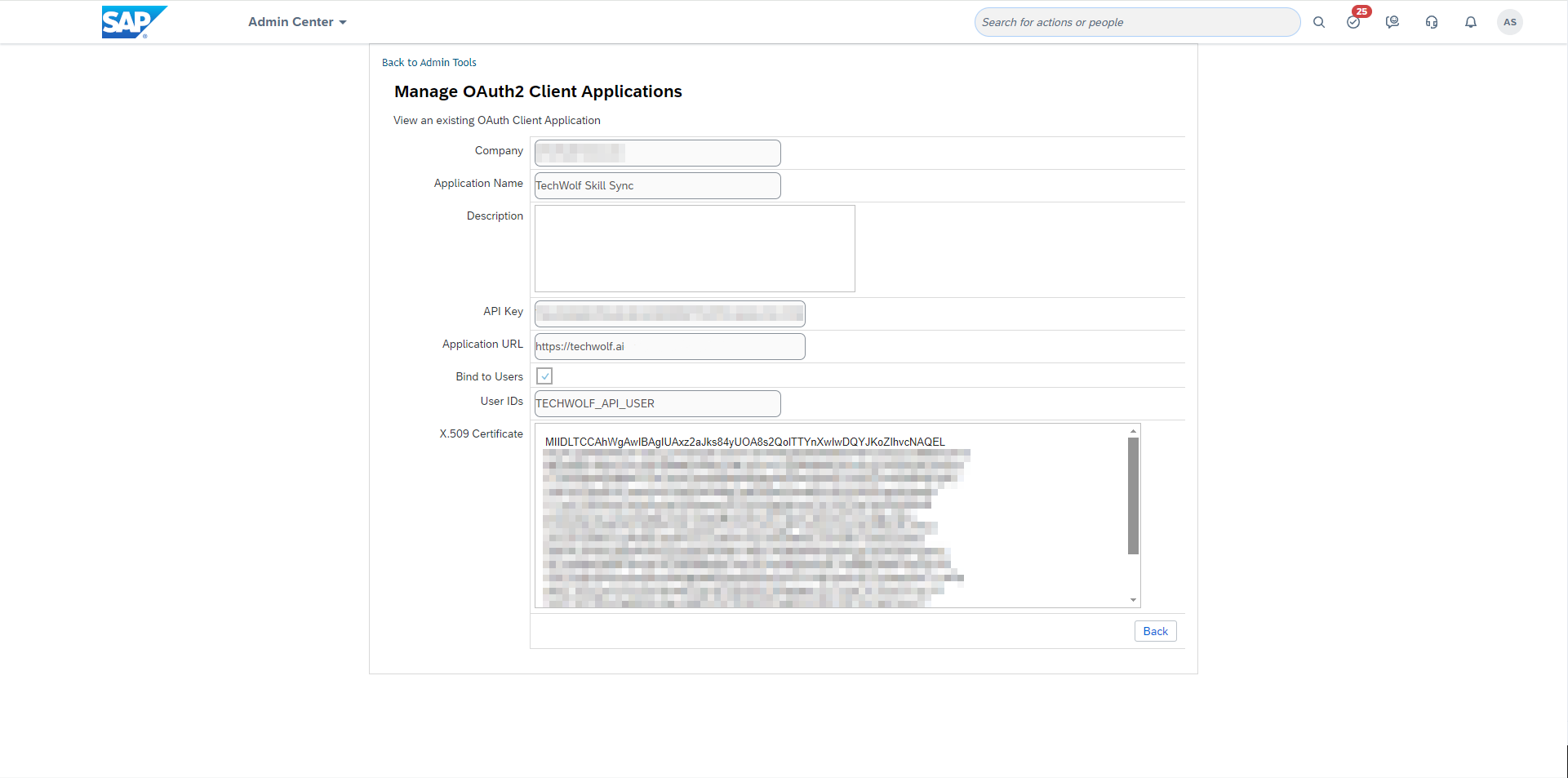
If you already created an OAuth2 Client Application for the another TechWolf - SAP SuccessFactors Integration, this step can be skipped. - In the search bar at the top right of the screen, enter
TechWolf Configuration
The TechWolf tenant will be configured by TechWolf itself.-
In the integration service on the TechWolf side, TechWolf adds the
credentials of the customer-created integration user. For this, the customer
will need to share the following values with TechWolf:
- The Company ID of the SAP SuccessFactors environment (see Step 1 of the SAP SuccessFactors Configuration section)
- The API URL of the SAP SuccessFactors environment (see Step 2 of the SAP SuccessFactors Configuration section)
- Username of the integration user (see Step 3 & 4 of the SAP SuccessFactors
Configuration section, will be
TechWolf_TIH_GPif not changed) - The API Key of the OAuth2 Client Application (see Step 4 of the SAP SuccessFactors Configuration section)
- The minimum proficiency level for skill attributes in SAP SuccessFactors (see How To: Manage the Skill Proficiency Rating Scale )
- The number of proficiency levels for skill attributes in SAP SuccessFactors (see How To: Manage the Skill Proficiency Rating Scale )
- TechWolf adds TechWolf API credentials with correct scopes to have access to the TechWolf API and links that TechWolf tenant to the SAP SuccessFactors tenant.
Configuration Options
Sync Direction Settings
The integration supports three sync direction options:- Bidirectional (default): Two-way sync between TechWolf and SAP SuccessFactors; changes made in TechWolf Job Skill Profiles are synchronized to their corresponding SAP SuccessFactors Job Skill Profiles, and vice versa.
- TechWolf to SAP Only: Skills flow from TechWolf to SAP SuccessFactors only; changes made in SAP SuccessFactors Job Skill Profiles are copied to their corresponding TechWolf Job Skill Profiles, while changes made in TechWolf are discarded and overwritten with the state of the SAP SuccessFactors Job Skill Profiles.
- SAP to TechWolf Only: Skills flow from SAP SuccessFactors to TechWolf only; changes made in TechWolf Job Skill Profiles are copied to their corresponding SAP SuccessFactors Job Skill Profiles, while changes made in SAP SuccessFactors are discarded and overwritten with the state of the TechWolf Job Skill Profiles.
Merge Strategy Options
For the correct functioning of the normal operation of the integration, the skill profiles in both systems should be initially aligned. The integration will do this initial alignment itself automatically when the integration is first enabled, or when it is re-enabled after having been paused, or when it encounters an job it had no knowledge about yet. The initial alignment can happen in different ways; the integration supports three such merge strategy options:- Merge Systems: Combines skills from both systems, i.e. the resulting skill profile in both systems will contain all skills that were present in either system initially. In case of metadata conflicts for skills present in both systems (e.g. conflicting proficiency levels), the values from TechWolf will be used.
- Push TechWolf: Uses the TechWolf Job Skill Profile as the initial source of truth, and will align the SAP SuccessFactors Job Skill Profile with it. Any skills initially present in the SAP SuccessFactors Job Skill Profile but not in the TechWolf Job Skill Profile will be removed from the SAP SuccessFactors Job Skill Profile.
- Push SAP: Uses the SAP SuccessFactors Job Skill Profile as the initial source of truth, and will align the TechWolf Job Skill Profile with it. Any skills initially present in the TechWolf Job Skill Profile but not in the SAP SuccessFactors Job Skill Profile will be removed from the TechWolf Job Skill Profile.
Deployment Tasks & Responsibilities
- TechWolf: Setup Skill Sync environment and tenant requirements
- Customer: Configure SAP SuccessFactors as described above.
- Customer: Share nessary SAP SuccessFactors information and credentials
with TechWolf:
- Company ID
- API URL
- Username of the integration user
- API Key of the OAuth2 Client Application
- TechWolf: Validate API access by attempting the addition, update and removal of a skill in the Job Skill Profile of the integration user.
- TechWolf: Run initial sync of user profiles with TechWolf API.
- TechWolf: Setup tenant configuration and start sync process based on configured direction.
- Customer: Check end-user test scenarios.